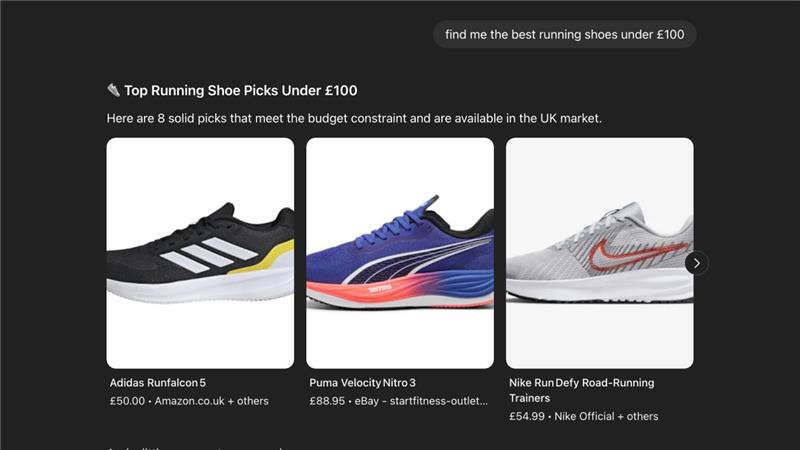AI powered shopping, what does this mean for your business?
In our guide, SEO lead, Birju Urmileche, dives into why AI-powered traffic to ecommerce sites has doubled every two months in the past year.
AI powered shopping, what does this mean for your business?
Artificial Intelligence is no longer a distant promise in the world of retail, it’s here, it’s growing fast, and it’s already changing how people shop. Over the past year, AI-powered traffic to ecommerce sites has been doubling every two months, according to Adobe’s Digital Economy Index (Forbes). That kind of growth doesn’t just hint at a trend; it signals a fundamental shift in consumer behaviour.
The tech giants know it too. Amazon has launched its own generative AI shopping assistant. Google is embedding AI deeper into its search experience. And most recently, OpenAI announced that ChatGPT can now provide live prices, reviews, and direct purchase links for personalised recommendations. A move that puts it in direct competition with marketplaces and search engines alike (Source: BBC).
For ecommerce businesses, the implications are clear, the way customers discover, compare, and purchase is being rewritten. The question is no longer if AI will reshape commerce, but how quickly you can adapt to stay visible, competitive, and profitable in this new ecosystem.
Where are your customers?
Research by McKinsey shows that 71% of consumers now demand personalised interactions, while 76% report frustration when they don’t get them. In practice, this means that product recommendations, offers, and content can’t just be relevant to a broad segment; they need to feel tailored to the individual.
Generative AI is making that level of curation possible at scale. What was once the role of a luxury department store, a personal shopper guiding choices, is now accessible to millions through intelligent assistants (Source: Bloomreach). Customers can describe their needs in natural language, and AI will surface products that fit their taste, budget, and intent with surprising precision.
At the same time, the traditional purchase funnel is collapsing. What once took multiple clicks, from search to comparison to checkout, now happens in a much shorter time.

A customer can ask Alexa to “order my usual coffee pods” or ChatGPT to “find me the best running shoes under £100” and the recommended products can appear due to plenty of different sources, including reviews, online conversations, SEO best practices, etc.

For retailers, the implications are profound. Success is no longer about ranking on Google alone. Visibility now means being present in the datasets and feeds that power AI systems, so your products are surfaced in those crucial zero-click decisions. Ecommerce has become intelligent, and businesses are required to keep up.
How is AI transforming ecommerce?
So where, exactly, is AI reshaping the landscape? The most significant opportunities fall into four interconnected areas:
1. Personalisation at scale
AI is taking personalisation far beyond “customers who bought this also bought that.” By analysing browsing history, purchase behaviour, and even real-time context, AI can curate experiences that feel unique to everyone.
From personalised homepages to predictive product bundles, these systems act like digital stylists, anticipating what customers want before they even articulate it. The payoff is commercial as well as experiential: McKinsey reports that companies using advanced personalisation see up to 40% more revenue from these efforts.
For business leaders, personalisation isn’t just a nice-to-have, it’s a growth engine.
2. Zero-click commerce
Perhaps the most dramatic shift is happening in discovery. AI-powered assistants are increasingly becoming the first stop for product searches. ChatGPT can now show prices and reviews, while Amazon’s AI assistant integrates recommendations directly into the shopping journey.
Even Google’s dominance in search, still at 89% of global traffic, is beginning to show signs of pressure (Source: BBC).
OpenAI’s search tool, integrated into ChatGPT, has quickly become one of its fastest-growing features, with more than one billion web searches in a single week (Source: BBC). This explosion in adoption shows how comfortable consumers are becoming with asking AI directly for answers, recommendations, and even product suggestions. And as adoption accelerates, the share of shopping journeys that begin and end inside AI ecosystems, without a single website visit, will only grow.
What makes this shift even more profound is how AI platforms are positioning their role in commerce. OpenAI has stated that its product selections are independent and not ads. Unlike Google, where visibility is often linked to PPC spend, or Amazon, where sponsored placements dominate results, OpenAI’s ChatGPT is framing its recommendations as trusted, impartial, and curated solely on relevance. For consumers, that creates a perception of authenticity and credibility and for online retailers, it raises the stakes. If your product data isn’t clean, structured, and accessible to these AI engines, you risk being excluded from the recommendation set altogether.
This is the essence of zero-click commerce. Discovery, comparison, and purchase are compressed into a single interaction, with the AI acting as the gatekeeper. The battleground for visibility is shifting from clicks on a search results page to answer placement inside AI systems. Optimising for this world, through structured data, reliable feeds, and what’s becoming known as AI engine optimisation (AEO) or generative engine optimisation (GEO) is critical for staying discoverable.
At true, we help brands optimise data, feeds, and content to stay discoverable in this new landscape.
3. Smarter service & quicker operations
AI is also transforming the less glamorous but equally critical parts of ecommerce.

AI-generated content may be incorrect. On the customer side, AI-powered chatbots and virtual assistants are handling everything from delivery updates to returns. But they’re no longer just cost-saving tools, they’re increasingly revenue drivers. Modern assistants can upsell, recover abandoned carts, and guide customers towards complementary products. That means service isn’t just solving problems, it’s creating further opportunities. Temple & Webster in Australia now handles 80% of customer queries with AI, cutting support costs by 60% and boosting profits five-fold.
Behind the scenes, AI is optimising operations. Demand forecasting algorithms help predict what stock will be needed, reducing waste and minimising stockouts. Dynamic pricing engines adjust prices based on demand, competition, and seasonality to protect margins. Together, these tools make businesses leaner, more responsive, and more resilient.
4. Content and campaigns
AI is revolutionising how marketing teams create and deliver campaigns. From generating product descriptions and imagery to writing copy and segmenting audiences, these tools allow brands to move faster, test more ideas, and optimise campaigns in real time. The result is sharper targeting, quicker turnaround, and greater efficiency.
But while the opportunities are clear, so are the risks. Over-reliance on AI-generated outputs can dilute brand voice, introduce errors, or even misrepresent products. Content produced without human oversight risks losing the nuance, creativity, and authenticity that consumers expect from trusted brands.
That’s why the most effective approach is AI-assisted marketing, not AI-only marketing. By combining the speed and scale of AI with the strategic direction and creativity of skilled marketers, businesses can strike the right balance, using AI to accelerate production and insight, while ensuring campaigns remain accurate, on-brand, and genuinely engaging.
For stakeholders, the key takeaway is this: AI should be a powerful ally, not a blind replacement. The businesses that win will be those that integrate AI into their workflows thoughtfully, keeping human expertise firmly in the loop.
Ready to see how AI can drive growth for your business? Contact us →
The commercial impact
What does all of this mean in hard numbers?
-
Businesses using AI personalisation can see revenue lifts of up to 40% (McKinsey).
-
AI-powered traffic to ecommerce platforms has been doubling every two months (Forbes).
-
Customer service automation can reduce costs by 30% or more, while improving satisfaction scores.
The business case is this: AI isn’t a cost to absorb, it’s an ROI driver. For stakeholders, the priority is no longer “should we adopt AI?” but “how quickly can we integrate it to capture value?”
The risks associated with ecommerce and AI
Of course, AI isn’t plug-and-play. Data quality, integration challenges, and questions of trust and ethics all need to be addressed. Customers may value AI recommendations, but only if they feel transparent and reliable.
That said, the bigger risk is inaction. With OpenAI, Amazon, Google, and others building AI ecosystems at scale, consumer expectations are moving faster than most retailers can keep up. Early adopters are already shaping the datasets and algorithms that will define visibility in this new landscape and those advantages compound over time.
Partnering for the AI future
true understand that for ecommerce leaders, the challenge is to cut through the hype and implement AI in ways that are practical, measurable, and aligned with business goals.
By blending strategic insight with technological expertise, we help businesses turn AI from buzzword to bottom-line growth. Whether it’s preparing your data for zero-click commerce, building personalised journeys, or automating operations, we make AI work in ways that drive real commercial impact. Get in touch today.


